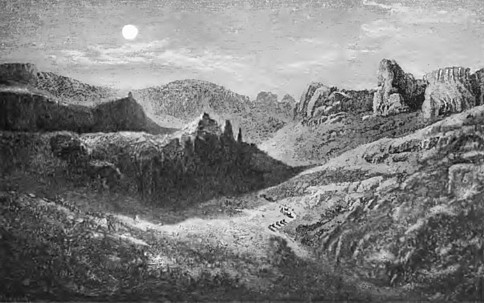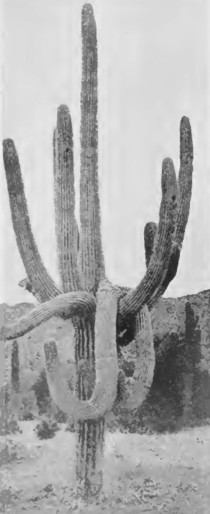Some small deposits of placer gold were found by Mexicans near the Colorado River at various times from 1775 to 1828, and in the latter year a similar discovery was made at San Isidro, in what is now San Diego County, and in 1802 a mineral vein, supposed to contain silver, at Olizal, in the district of Monterey, attracted some attention, but no profitable mining was done at either of these places, "Forbes, who wrote the history of California in 1835, said: 'No minerals of particular importance have yet been found in Upper California, nor any ores of metals.' From the extracts which I have given above, it would seem that Arizona was the first of the territories under the American flag, west of the Mississippi River, in which native gold had been discovered, but it remained for the opening of the large placers along the Colorado River, the discoveries made by the Walker party, and by other adventurers in 1862 and 1863, to attract general attention to the mineral resources of Arizona. Bancroft says the Mission Fathers never did any significant mining in Arizona. Hamilton and others claim to the contrary. The following, in reference to the first placer mining in the State of Arizona is taken from Elliott's History of Arizona, 1884: "But there is evidence of still earlier discoveries and extensive workings. To the north of the Quijotoa Mountains about six miles, there is an area of about three miles square, more or less, of placer ground, which has been extensively worked (from the most reliable authority) as early as 1774, by Padre Lopez, a Castilian priest, and up to 1849, when the California gold rush excitement of caused many to leave for the north, the remainder returning to Lower California, whence they had come. The workings of the placer are remarkable. The most of the ground is a perfect honeycomb of working shafts from five to twenty feet deep, covering the gold field—so close together that it is almost impossible to ride over the ground without danger. These shafts or pits are connected by underground workings, from which the gold ore was evidently taken. The deepest shafts are those furthest removed from the base of the mountain. Some of the dumps of the deep workings are very large, and have been found rich enough to work with profit, as the methods used by ancient gold miners of that region were so crude and primitive that none but the coarse gold was taken. Several parties now working on the dumps are making from $3.00 to $5.00 per day."
Gold placers were discovered on the Gila at what was called Gila City, in 1858, by Jacob Sniveley. Sniveley was Sam Houston's secretary when Houston was President of the Lone Star Republic; and commanded a force of two or three hundred men which Texas sent out to operate against the Mexicans on the Santa Fe Trail. This force was captured by the American military authorities and disbanded. Sniveley came to Arizona somewhere about the year 1857. He was a Pennsylvanian by birth, and was killed by the Indians, as will be seen later in this history. Sylvester Mowry, in speaking of these placers at the time he visited them in 1859, says:"The facts in reference to the present condition of the Gila gold mines in Arizona are simply these: At a point on the Gila River, about twenty miles from its junction with the Colorado, and in a succession of sand hills gold was discovered in September, 1858. The emigrants who were still on their way stopped, and, the news reaching California, others came in. I visited the gold mines early in November, and found about one hundred men and several families. A town called Gila City had been already laid out, and temporary houses of brush and adobe were in the course of erection. I examined carefully for myself, and found that several men could afford to pay laborers three dollars per day and their board to work for them. I saw more than twenty dollars washed out of eight shovels full of dirt, and this in the crudest manner, and by an unpracticed hand. I saw several men whom I knew well would not have been there had they not been doing well, who told me they had made from $30 to $125 per day each. I purchased about $300 in gold dust out of a lot of more than $2000. A portion of this dust is here, if anyone is curious enough to wish to see it. Several hundred men have gone into the mines since I left Arizona. My letters give me no reason to suppose the mines have given out or show any signs of failure." Pauline Weaver, the old guide and frontiersman, discovered the placers at La Paz, on the Colorado River, about the year 1861. He washed out a little of the dirt in a pan, and, not knowing what it was, took it to Yuma and showed it to Jose M. Eedondo, who declared it to be gold.
Soon thereafter a thriving settlement was established there, with, Hamilton says, a population of about two thousand souls. These placers have long been worked out. In 1862, Pauline Weaver, Peeples and Jack Swilling discovered what is known as Weaver Diggings, near Stanton, which was found only by an accident. On the top of a high mountain, flat on the surface, were discovered the richest placers ever found in the State. One of the parties having lost an animal, which had strayed upon this table mountain, went in search of it, and discovered nuggets of coarse gold. The ground was immediately staked out and worked, and yielded, it is said, within a small area, something over a million dollars. Weaver Creek is still worked to some extent.
In 1861 the Walker party was organized in California for mining explorations in Arizona; after a long and severe trip they arrived in Prescott, and began placer mining on Granite Creek and other creeks adjacent to the present town of Prescott. The area of these placers was quite extensive, extending to Turkey Creek and to the Big Bug District. There was a great deal of gold taken from these placers. The full account of this expedition will be given farther along in this history. Henry Wickenburg discovered what is known as the Vulture Mine in 1863, and probably the most authentic account of this discovery is given in the Prescott Miner of June 6, 1868. This account was written by a correspondent of the Florida Press at Wickenburg from the story as told by Henry Wickenburg himself, and is as follows: ''He (Wickenburg) came in with Bloomfield in 1863, and with another companion. He left that gold seeker in a few weeks. The two men spent long months hunting for gold through the mountains. Wickenburg 's companion at length became sick and weary and stayed in camp while Wickenburg prospected the hills.
One hot day Wickenburg, weary and faint, sat down on a hill 15 miles from the Hassayampa, the nearest water. His spirits were all but broken and his money spent. He was attracted by the appearance of the country, and on examining it, he found his resting-place to be the croppings of a gold-bearing quartz lode, unequaled in these mountains famous for their mines. Wickenburg returned to his companion, who would not credit his story. At last they parted ; the one to return with Wickenburg's crazy story, Wickenburg to remain, mining his treasure. Here, far from white men, surrounded by hostile Indians, with none but his life to give him food,
Wickenburg remained for seven months, his faith increasing in his discoveries. White men came at last, and found that Wickenburg was right. The mine was taken up, and a shrewd miner, Mr. Phillips, of New York, hurried out, and Henry Wickenburg sold his discovery, except one-fifth, which he holds, for $85,000.00. Wickenburg, through sharpers and bad investments, has lost the greater part of his fortune, but he has enough in reserve. In regard to the story of Wickenburg and his discovery of the Vulture Mine, the editor of the Miner saw fit to add a note as follows: 'The above, as far as we know, is correct, with the exception of the wife part. That is news to most of Wickenburg's acquaintances here. The imaginative mind of the writer blundered up that part of it to be sure, as we know Henry to be virtuous." Reports concerning these discoveries of gold in Arizona which were, no doubt, greatly magnified and exaggerated the farther they were carried, probably induced Congress to organize the Territory of Arizona, as the Government, at that time, was much in need of gold.
Return
to The Arizona Page:
Arizona Gold Rush Mining History



